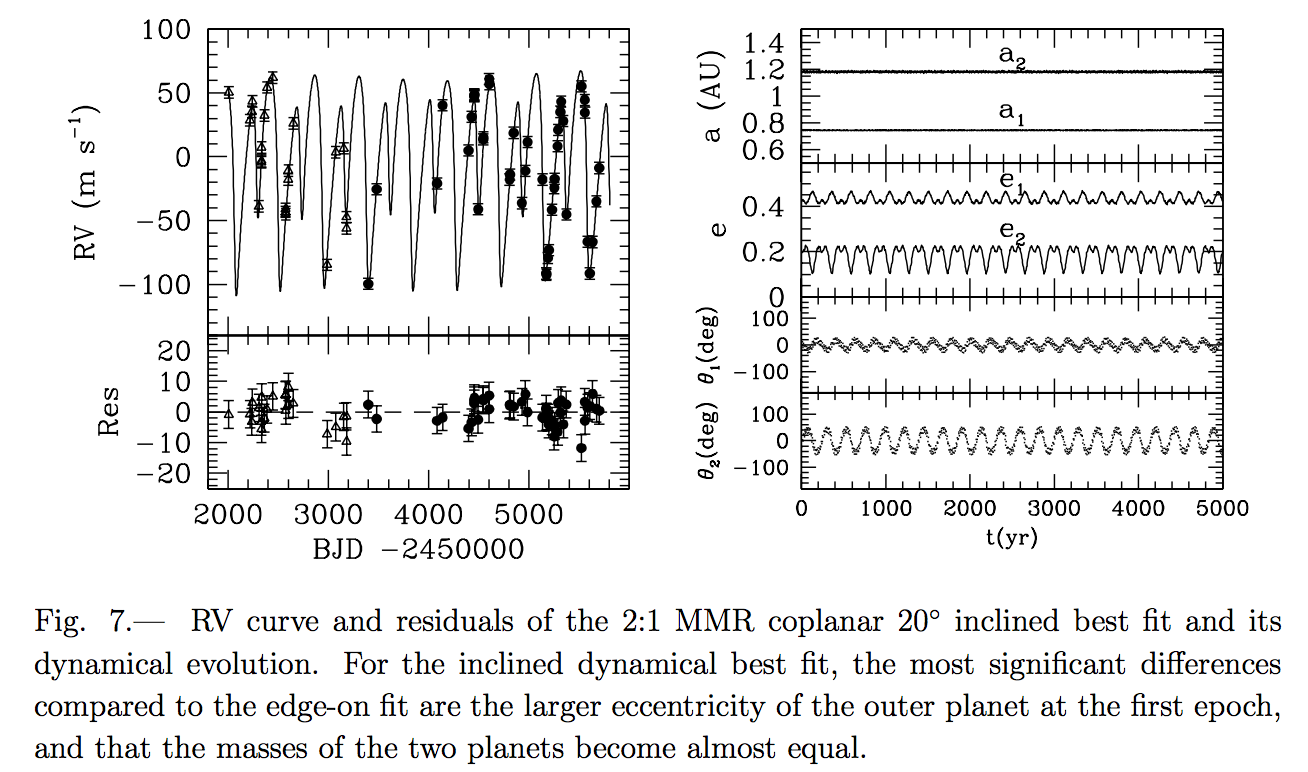When we discover planets with the radial velocity method, we generally just get five pieces of information:
- The orbital period
- The minimum mass of the planet (technically, the mass function of the binary system, but we usually know the mass of the star pretty well so this is equivalent).
- The orbital eccentricity of the planet
- An orientation of the point of closest approach with respect to the line of sight (the argument of periastron)
- The orbital phase of the planet during the observations
When two planets are discovered, however, a whole world of additional information opens up to us. Xianyu Tan of Hong Kong University, working with his thesis adviser Man Hoi Lee, has analyzed a classic 2-planet system, HD 82943. This has always been one of my favorite systems. It was announced back in 2000 by the Geneva team, but not published until 2004 as part of a big 16-pack of exoplantary systems. It is a pair of planets in a 2:1 mean motion resonance, with orbital periods 220 days and 440 days; the planets are at least 2 times the mass of Jupiter, each.
The mean motion resonance means that the planets are perturbing each others’ orbits so much that the five pieces of information we get are actually changing quickly enough for us to detect. As a result, one can determine the true masses of the planets involved.
Determining whether a system is in true resonance (that is, that the orbital periods, on average, are dynamically locked in a near-integer ratio) requires demonstrating that certain resonant arguments librate (oscillate) around a fixed value, as opposed to circulating (varying by an arbitrarily large amount). It requires a lot of radial velocity information to do this, because the effects are quite subtle, but demonstrating that it is happening can reveal a lot about the origin of the system.
Detecting these interactions also allows one to put constraints on the true masses of the objects in the system, and thus determine the inclination of both of the planets in the system. The only remaining unknown orbital parameter is then the longitude of the ascending node of the two planets, which does not contain any physically interesting information unless one can actually image the system (which we cannot).
Detecting these interactions also allows one to rule out more exotic explanations for the radial velocities we see in this system, including the possibility of 1:1 resonance (two planets sharing the same orbit) or a 1:2:4 “Laplace resonance” (like the one claimed for GJ 876).
Not many planetary systems have all of this information worked out for them, so it’s a big advance for us to be able to add HD 82943 to the list. It turns out that both planets are almost five times the mass of Jupiter! Monsters in a dance it takes centuries to see.
Congratulations, Xianyu, on a very nice piece of work! The paper is now accepted to the Astrophysical Journal.
Incidentally, there were some issues getting all of the co-authors properly listed on this paper. Representative Frank Wolf (R-VA) put an amendment into effect in 2011 to NASA’s funding that bars any cooperation with China. There is no exception for purely scientific research, with no military or space application. Since some of the American co-authors have NASA funding that could have been used to do work on this project, we had to go out of our way to make sure that we didn’t do any work on this project on NASA’s dime after the amendment went into effect. We managed it fine and didn’t bend any rules, but it seems an absurd thing for us to have had to worry about — one would think America would be pleased to have such great science come out of NASA’s investment into astronomy! Instead, we had to carefully avoid that outcome.

